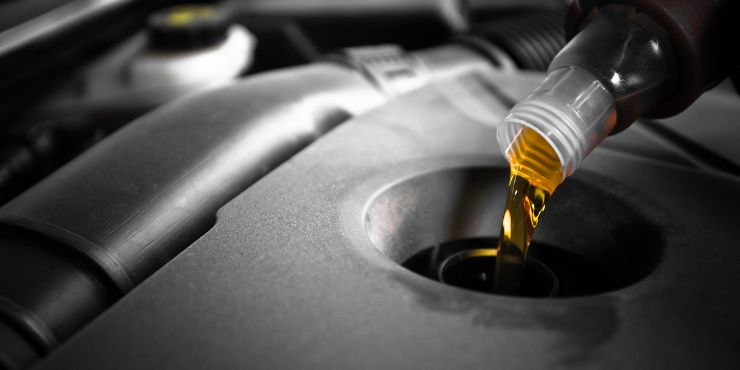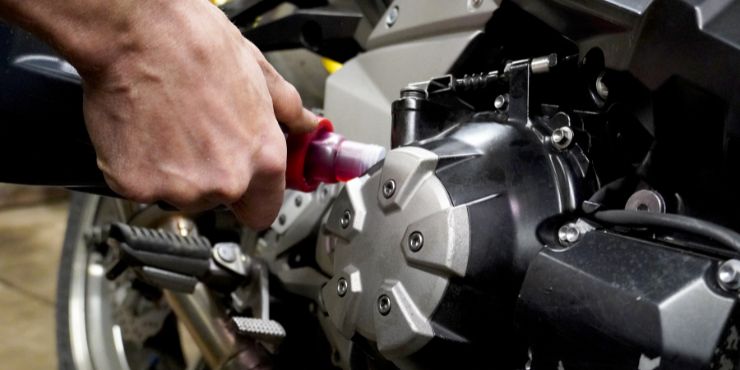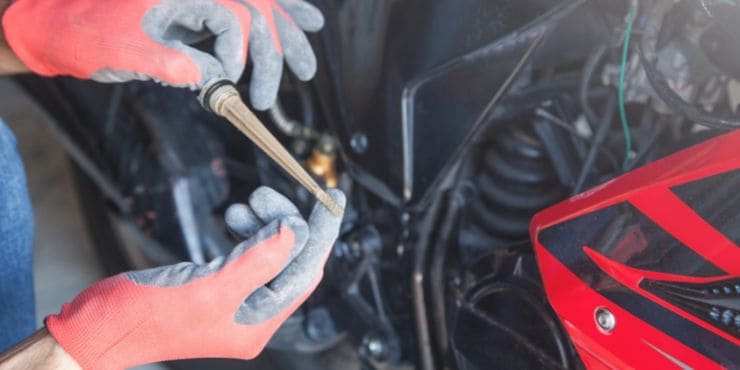Do you own a Harley-Davidson motorcycle, and you need to find out exactly how many quarts of oil your bike needs? If so, then you are definitely in the right place.
Most Harley-Davidson models take between 3 to 4 quarts of oil, depending on the model and engine size. Check your owner’s manual for the exact amount.
In this article, you’ll get to know all about oil in Harley-Davidson bikes, how many quarts of oil does a Harley-Davidson take, what does engine oil do, the difference between different Harley-Davidson oil options, will a high-performance oil deliver more power, and more. Stick around to get all the answers that you’re looking for.
What does Harley-Davidson engine oil do?
A decent engine oil option can easily lubricate, protect, clean, and cool the engine while keeping it running smoothly. Engine oil will provide the needed lubrication between different engine components and reduce friction. It’ll do so by offering a slippery film between the moving parts of a running engine. It’ll ensure that the engine is capable of running effectively at increased power and at optimal performance. Lubrication is important when starting your Harley-Davidson bike.
Here, the cold oil in the oil sump will have to be quickly pumped back into the engine such that it’ll provide lubrication. This will allow for an ideal cranking speed when turning over the engine. To ensure that the oil can flow quickly at start-up while also providing a film enough to protect the engine when running, the engine requires an oil with different viscosity ranges.
Engine oil will create a film on the motor of the engine, which will act as the protective layer. By preventing or minimizing metal-to-metal contact, the wear of the components will be reduced. Engine oil has a way of protecting the engine. Oxidation, combustion by-products, and contamination from condensation will all form acids. If it’s left unchecked, these acids could end up causing corrosion in the engine, leading to components failing. Engine oil can ensure that it doesn’t happen and protects the engine while doing so.
For the engine to run properly, it has to be properly cleaned. The deposits in the engine could easily gum it up while reducing its performance. Further, any unnecessary wear or damage to the engine could be caused by microscopic contaminants. Contaminants as small as 5-20 microns can easily result in damage to the engine. Engine oil can keep the engine clean by holding the contaminants in suspension until they’re removed via the oil filter.
Lastly, engine oil helps in keeping the engine cool. Heat is normally caused by the friction between the moving parts and by combustion. The radiator will be responsible for cooling the top portion of the engine. Cooling the remaining part of the engine like the crankshaft, the pistons, timing gears, and road bearings will be up to engine oil. As engine oil passes over the heated surfaces, it will absorb the heat. This oil then travels to the oil sump, where it will be cooled by the air surrounding it.
How many quarts of oil does a Harley-Davidson take?
When adding oil to your Harley-Davidson bike, it can easily take around 3-4 quarts of oil. When changing the oil in your Harley-Davidson bike, you’ll first need to gather the supplies and necessary tools. There will be three quarts (2,800 ml) of engine oil needed. If you have oil in the sump, you should fill it with 2 quarts (1,900 ml) and then check the dipstick for ensuring that it is not broken. Dip the dipstick in the oil to ensure that it is between low and high indicators. The fill cap will also have to be replaced.
If you love your motorcycle, you will need to change the engine oil regularly. If you’re doubting whether to change the oil, you should be on the side of caution and just do it. Many people state that their motorcycle leaks oil all the time. As a result, they end up constantly adding oil and believe that it should be clean. This is the wrong way to go. While it’s a common misconception, adding oil and not changing it at once isn’t the same as changing your oil.
One of the properties of a high-quality oil option is the ability to trap and contain contaminants and other particular matter that develop during internal combustion. Extensive heat, changing weather conditions, time, and other factors can degrade engine oil. The rule of thumb for changing oil is to do so after either 3,000 miles or every six months. You can do it quicker if your bike has been ridden hard for long periods of time. The cleaner you keep your bike’s oil, the longer it will stay healthy and in decent running condition.
The filter has to be changed when the oil is changed. The oil filter stops being effective when contaminants get trapped in its inner pleats. If the filter is allowed to be extremely dirty, it’ll stop working altogether. Moreover, it will allow oil to flow through the bypass valve. It needs extra horsepower for forcing oil through the bypass. This essentially means that motor oil isn’t doing its job of trapping particles and protecting the motor. A clogged filter will create a parasitic drag, meaning that your bike is running with fewer ponies.
Changing the engine oil and filter for a Harley-Davidson bike is a rather easy procedure. All the aspects of the motorcycle that have to be tinkered with for the procedure are easily accessible. Moreover, you will only need a few simple tools – a filter wrench, a screwdriver, a drain pan, and a funnel. If you acquire the necessary fluids and filter before starting, it won’t take you more than half an hour for changing the oil and filter. This also includes hand-washing the bike afterward.
What is the difference between different types of engine oils?
Mineral oils are generally refined from petroleum, but even they contain synthetic compounds or additives for improvising them. Semi-synthetic oils are essentially a mixture of mineral and synthetic oils. These contain definite improvements over pure mineral oils while also having hydrocracked bases.
Hydrocracked oils are mineral oils that are subjected to intense pressure and temperature. This changes the structure of the molecules, which makes the resultant oil more stable and resistant to evaporation at higher temperatures. Semi-synthetic oils do not cost that much more than mineral oils, while also offering certain advantages.

Full-synthetic oils are more expensive compared to mineral or semi-synthetic oils. These oils are man-made oils that are tailored to give certain advantages, like the fact that they perform a lot better in extreme temperatures. Moreover, they are less likely to evaporate or thin when in excessive heat. Full-synthetic oils contain poly-alpha-olefins (PAO) and esters. PAOs do not actually get at low temperatures, which makes them necessary for true 0W oil options.
Esters are very similar to PAOs, but they also help in protecting metal surfaces and offer amazing lubrication. Full-synthetic oil options are pretty expensive and unless you’re racing, it isn’t recommended for bikes. For an everyday biker, a semi-synthetic shear-stable 10W-40 oil with ester content is a great choice.
Do high-performance oil options offer more power?
More often than not, there will be a loss of engine output because of things like thermodynamics. You cannot really do much to change it. Some loss, around 6% will be because of oil drag. If you’re using a high-quality but low viscosity oil, the loss can be minimized and engine power improved. For a typical 100BHP bike, a lighter engine oil option may show a 2BHP peak improvement.

Your ideal choice of oil will be an ester semi-synthetic 10W-40 or a 10W-30 oil that is shear-stable. The fact that your oil is shear-stable is more significant than the fact that it’s semi-synthetic. You’ll still be better off choosing shear-stable mineral-based oil than low-quality semi-synthetic oil that is not shear-stable. The cost of full-synthetic oil will only be worth it for frequent long-distance riders. It will help save on fuel costs and oil changes.
If you’re changing the engine oil, it’ll make sense to change the oil filter as well. An oil filter will remove tiny particles from the oil. This helps to keep the oil fresher while working to its best ability for longer. A new filter will cost a few bucks, and it’ll only take you a few minutes to change.
Conclusion
Thank you for reading. Hopefully, now you know all about oil in Harley-Davidson bikes, how many quarts of oil does a Harley-Davidson take, what does engine oil do, the difference between different Harley-Davidson oil options, will a high-performance oil deliver more power, and more. On a Harley-Davidson motorcycle, the average number of oil quarts that you can take is 3-4 quarts. A decent engine oil option needs to lubricate, protect, clean, and cool the engine and keep the bike running smoothly. Ideally, you should want to choose an oil option that is ester semi-synthetic 10W-40 or a 10W-30 that is also shear-stable.

